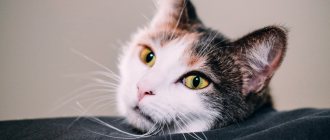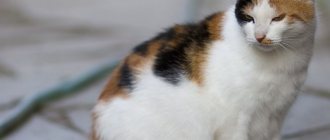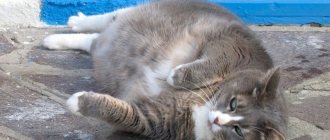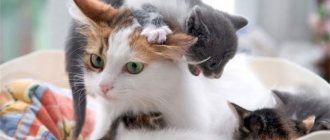What to do if your cat has a miscarriage?
To avoid serious complications, it is important to first find out why the cat had a spontaneous abortion. Therefore, even if the animal feels fine after a miscarriage, it should still be shown to a veterinarian, who, after an initial examination and history taking, will give directions for additional diagnostic tests:
After the incident, it is advisable that the animal be examined using ultrasound.
- blood and urine tests;
- biochemistry;
- tests for hormonal levels;
- tests for the presence of viral infectious pathogens in the body;
- examination of a smear taken from the vagina;
- radiography and ultrasound of internal organs.
In addition, the veterinarian examines the aborted fetuses in detail, so the owner needs to take them to the hospital. When the exact diagnosis becomes known, the doctor will select the optimal treatment regimen that will help eliminate the pathology that caused the spontaneous abortion. Veterinary specialists often advise owners to sterilize their pet after a miscarriage, of course, if it does not actively participate in the reproduction of offspring. This will help avoid complications in the future and prolong the life of your pet.
Return to contents
Prevention measures: how to prevent miscarriage?
Timely preventive measures will help reduce the risk of early or late miscarriage in a cat, as well as prevent life-threatening complications. First of all, the owner needs to prevent the crossing of closely related pairs, since inbreeding often leads to congenital anomalies of intrauterine development and premature birth. You should not breed a too young or elderly female. In the first case, it is important to wait until physiological maturity, which approximately occurs at the age of 1.2-1.5 years. When the cat turns 5 years old, it is better to sterilize it, because age-related changes negatively affect pregnancy and childbirth.
In addition, it is important to prevent injuries, falls, and poisoning. Before mating, it is recommended to examine the cat’s body for the presence of viral infectious diseases, including chronic ones. After conception, it is important to monitor your pet’s diet, give vitamins and other useful supplements on the advice of a veterinarian, stimulate physical activity, and prevent excessive weight gain.
Possible complications after a miscarriage
If a miscarriage occurs in the early stages, the owners do not notice it. It can also pass without a trace for the pet’s health. Spontaneous abortion after 6 weeks can have serious consequences. The embryos are already large, their rejection can lead to:
- rupture of the uterus, birth canal and perineum;
- tissue necrosis;
- pyometra - accumulation of pus in the uterine cavity;
Pyometra is purulent endometritis, accompanied by accumulation and retention of purulent exudate in the uterine cavity. - sepsis (leads to the death of the pet).
If the fetuses are not expelled from the uterus, but die in utero, this is a very dangerous condition for the cat, as they will begin to decompose, poisoning the pet’s body. The uterus itself becomes inflamed. As a result, intoxication occurs, as a result of which the animal dies. In this case, the cat can only be saved by the attentiveness of the owner, who will notice in time that something is going wrong and contact the veterinarian. The first signs of this condition:
- increased temperature in a cat;
- the appearance of purulent leucorrhoea (discharge from the loop) with a pungent odor.
[custom_ads_shortcode2]
Symptoms of miscarriage
Before moving on to answering the question of what to do if a cat miscarries, you should understand several aspects of this problem. In particular, find out what the symptoms of a miscarriage in a cat may be.
© shutterstock
No signs of pregnancy
Miscarriage in a cat is often complicated by the fact that its signs are often almost invisible to the owner of the animal. Sometimes you can find out that a miscarriage has occurred only by noticing the absence of signs of pregnancy in your pet. The fact that the cat does not develop a belly, although it should, and also does not grow in appetite, is often associated precisely with the loss of the fetus.
Bad feeling
After a miscarriage, the cat often doesn't feel well. This can manifest itself both in the form of a strong increase in temperature (above 39 C), and in the form of lethargy, diarrhea, vomiting, long-term lack of appetite, etc.
Soreness, discharge, odor
In addition, a miscarriage may be indicated by such signs as pain in the cat when you feel its abdomen (it dodges, meows, etc.), discharge from the genitals (including bleeding) and/or an unpleasant odor from them same.
Anxiety, nervous condition
You should also start to worry if you notice an unusual state of the cat: increased agitation, a nervous state, anxiety, etc. All this can also be symptoms of a miscarriage.
If you notice at least one of the listed symptoms in your pregnant pet, you should immediately contact your veterinarian.
Types of miscarriages in cats
Fruit resorption
A miscarriage in a cat in the early stages is most often accompanied by resorption of the fetus. Such a miscarriage does not pose a threat to the animal. In addition, with it there is a possibility that one or more fetuses will not die, but will develop further in the womb.
Death of fruits
With this type of fetal loss, they can die at any stage of pregnancy. Such a miscarriage is more dangerous for the cat, because... accompanied by bleeding and discharge of pus. But in the absence of complications, this miscarriage may not be noticed by the animal’s owners, because she usually eats the fruits.
Death of fruits without their release
This kind of intrauterine miscarriage is the most difficult, as it causes severe inflammation of the genital tract, bleeding and the release of pus/mucus.
Factors that provoke miscarriage
The root causes of a frozen pregnancy in a cat can be very diverse, but the most common are:
- Age. Both older and younger cats are at risk. Pets less than a year old often give birth to premature and non-viable kittens. In cats after 5-7 years of age, miscarriages are associated with physiological age-related changes in the body, under the influence of which the animal is not able to fully bear offspring.
- Inbreeding. A common reason why a cat miscarries in the early stages. If mating occurs among closely related pets, the likelihood of developing intrauterine anomalies and premature birth increases many times.
- Poisoning. Profuse vomiting, poor general health, internal bleeding are signs of severe poisoning. In this case, the body tries to get rid of everything that in one way or another interferes with normal recovery, including kittens developing in the stomach.
- Viral infectious diseases. If a cat has chronic fungal, infectious or acute viral diseases, even in the later stages they can cause complications and provoke the death of the offspring.
- Obesity or dystrophy.
- Congenital or acquired pathologies of the structure of the organs of the reproductive system.
- Hormonal imbalances.
Other reasons
Certain drugs, if taken uncontrolled, can lead to this condition in the animal.
The course and favorable outcome of pregnancy are affected not only by internal, but also by external factors. The following exogenous factors can provoke miscarriage in cats early or late:
- uncontrolled use of medications that negatively affect fetal development;
- stress;
- a large number of pregnancies in a short period of time;
- injuries, bruises.
Consequences of miscarriages
Spontaneous abortion in most cases is stressful for the cat's body. The only exception is that fruits that dissolve in the early stages do not cause any discomfort. The following miscarriage scenarios are most dangerous for a cat’s health:
- miscarriage in late pregnancy.
It is logical to assume that the more developed the fetuses are, the more painful it will be for the animal to experience their exit from the uterus. Such a miscarriage sometimes ends with rupture of the reproductive organ or birth canal. Even if this does not happen, the animal is severely emaciated due to the loss of a large amount of blood; Miscarriage in late pregnancy is the most difficult for cats - miscarriage not accompanied by expulsion of the fetus from the uterus.
Decaying embryos poison the cat’s body and in the future can even lead to necrosis of the uterus if they are not removed from it in a timely manner. Another serious consequence of this type of miscarriage is infection of the pet’s blood. The consequences of a miscarriage are not always visible to the naked eye.
Regardless of the type of miscarriage, veterinarians note the following impact of this unpleasant episode on the cat’s future life:
- the animal has permanent foci of inflammation of the reproductive organs;
- experienced spontaneous abortion most likely leads to infertility of the cat;
- a miscarriage will likely have a negative impact on all subsequent pregnancies, worsening their course and complicating labor.
Sometimes, after a miscarriage, a cat loses the opportunity to become pregnant again.
Possible consequences
A frozen pregnancy in a cat is itself a symptom that not everything is in order with the animal’s body. Therefore, if your pet has ever had a miscarriage, the veterinarian will advise castrating her to avoid dangerous complications in the future. If preterm labor begins late in pregnancy, the risk of serious damage to the uterus and birth canal increases. In addition, miscarriage is often accompanied by heavy bleeding, untimely elimination of which can cause the death of the cat.
The longer the dead fruit remains inside the animal, the higher the risk of developing pyometra.
If the fruits decompose inside the womb, an inflammatory-purulent complication in the uterus rapidly begins to develop, leading to pyometra and sepsis. Often a miscarriage leads to the following complications:
- endometritis;
- formation of malignant tumors;
- hormonal imbalance;
- chronic inflammatory processes in the uterus and birth canal;
- decreased protective functions of the body.
Other complications of pregnancy in cats (dangerous)
1) Uterine bleeding in cats
It is characterized by copious discharge of blood and blood clots from the cat's vulva.
Causes of uterine bleeding in cats: trauma, exposure to pathogenic microorganisms on the placenta.
As a rule, uterine bleeding provokes or is a sign of miscarriage in cats; but with timely veterinary intervention, a cat’s pregnancy can be saved.
2) Torsion of the uterus in a cat
There is a twisting, twisting, bending, bending of one of the “horns” of the uterus (the cat’s uterus is bicornuate, i.e. has the shape of the letter Y).
Causes of uterine torsion in cats: trauma.
Leads to intrauterine death of the fetus(es) without miscarriage and removal of the uterus; with timely veterinary intervention, and if torsion occurs late in pregnancy, kittens can be removed by caesarean section.
3) Ectopic pregnancy of a cat
An ectopic pregnancy in a cat is primary - the fetuses immediately begin to develop outside the uterus; and secondary - the fetuses develop outside the uterus due to its rupture.
Causes of ectopic pregnancy in cats: unknown (primary ectopic pregnancy); trauma, pathology of the uterus/oviducts, etc. (primarily thinning of their walls, leading to ruptures, with secondary ectopic).
In all cases, it leads to the death of the fetus and its surgical removal; in the absence of timely surgical intervention, sepsis and necrosis develop, which can lead to the removal of some of the cat’s internal organs or to its death. Happens extremely rarely.
4) Post-term pregnancy with a cat
It is characterized by the absence of labor in a cat after the 70th day of pregnancy.
Reasons for post-term pregnancy with a cat: intrauterine fetal death, large fetal size, large number of fetuses, hormonal imbalance; pathology of the cat’s reproductive tract (narrow pelvis, etc.)
Post-term pregnancy with a cat usually results in a cesarean section with removal of the fetus (live or dead).
If timely surgical intervention does not affect the cat’s health in any way; if untimely - sepsis, necrosis, death of the cat.
Why is surgery dangerous during pregnancy?
During pregnancy, surgery poses a serious risk to the health and life of the cat. The danger is as follows:
- Loss of a significant amount of blood. Blood loss during surgery is inevitable in principle, and if there are embryos in the uterus, they increase many times over.
- A large number of postoperative sutures, which will greatly disturb the cat.
- A long postoperative recovery, which may end unfavorably for the pet’s health. Hormonal and physiological stress doubles during pregnancy, which can negatively affect your well-being.
Important! In order for the procedure to go as smoothly as possible and with fewer consequences, the owner needs to prepare in advance for his cat’s surgery: find out all the details of the procedure, weigh the pros and cons, find a good clinic and first-class specialists. Only in this case can you count on a favorable outcome of the operation with fewer risks to the cat’s health
Preventing miscarriage
Miscarriage in a cat is rare. For the most part, pregnancy proceeds without any particular complications, and the cat also copes with childbirth on its own. But this situation can and should be avoided:
- If a cat’s pregnancy is planned (this applies to breeding sires), then before conception the cat should be examined by a veterinarian for possible diseases and preventive measures.
- If the pet is of “noble” origin, this does not negate the fact that it has all the required vaccinations and anti-parasitic treatment procedures. If a person has taken responsibility for an animal, then it should be fulfilled in full.
- You should not suddenly change your diet once you become pregnant. The cat should eat its usual food.
- It is necessary to take a course of vitamins during pregnancy, which will be recommended by the veterinarian.
Observation by a veterinarian
As mentioned above, consultation with a specialist is necessary before planned conception. But even during pregnancy you should not neglect visiting a doctor:
- the veterinarian will give the necessary recommendations, prescribe a course of vitamins, and examine the cat by taking samples;
- after the 4th week, you can do an ultrasound to make sure that the kittens are alive and positioned correctly, the uterus is in good condition;
- Closer to childbirth, it is better to invite a doctor for an examination at home, so as not to irritate your pet with the trip, he will make sure that she is feeling normal and there are no signs of premature birth.
Nutrition
A cat's diet during pregnancy should be balanced. She should receive enough vitamins. This is not difficult to do if the cat eats dry food. Many manufacturers have lines of food specifically for expectant mothers.
High-quality dry food intended for pregnant and lactating cats will provide their body with all the necessary elements
If the cat eats natural products, then taurine should be included in the diet. This element prevents premature termination of pregnancy and reduces the risk of abnormalities in the fetus. It is impossible to overdose; excess is simply eliminated by the body. It is contained in:
- red meats and fish;
- chicken heart and liver;
- turkey meat (champion in taurine content).
The need for rest
During pregnancy, the cat needs to be given the maximum opportunity to rest peacefully. The animal's activity decreases. It is very important to explain to children that rough play with a pet is unacceptable. You should not pick up the cat unless necessary, so as not to put pressure on the stomach.
Treatment and further care of the cat if a miscarriage has already occurred
After a miscarriage, the cat must be shown to a specialist. Usually owners panic and simply call a doctor to their home. This is a very correct decision, because the cat needs help as early as possible. But after the incident, in any case, you should visit a veterinary clinic. The specialist will perform an ultrasound to ensure that all kittens have been born and will prescribe hormone therapy to completely cleanse the uterus.
An ultrasound after a miscarriage helps make sure that there are no embryos left in the uterus
Necessary medications
If it is not possible to quickly call a doctor, then glucose solution and Travmatin will help the owners. They will greatly ease your pet’s condition and help him recover. They must be used according to the instructions, but it is better to consult with a veterinarian, at least by phone.
Travmatin is a complex homeopathic preparation that, thanks to a unique combination of components, has the ability to have a beneficial effect on the source of inflammation, significantly accelerating the restoration of damaged tissues in the animal’s body.
Telephone consultation is a service that is now quite common. Having several cats and a dog, I also have a permanent doctor who takes care of them and gives them vaccinations. His phone is magnetically stuck to the refrigerator door so that in case of an emergency, I or the rest of the household can contact him. So, when we took in foundlings for our nursing cat, one of which was very weak, it was over the phone that the doctor suggested how to supplement the baby’s feeding and properly care for him.
The doctor will also prescribe antibiotics to exclude the addition of a bacterial infection and the development of inflammation.
Diet
There is no need to adhere to a special diet. Your cat should always have clean, fresh water. The food itself can remain familiar. But if the animal is in serious condition, is unable to eat on its own, or it is difficult for him to cope with dry food, then at first you can feed the cat with formula or cereals for infants. This type of nutrition is especially important if a caesarean section was performed. In addition, the cat may become constipated, and such food will relieve tension on the seam at the time of defecation.
Rest
You need to understand that the cat suffered serious stress with the miscarriage. Especially if there was medical intervention. Therefore, you need to provide her with a secluded place to rest. There is no need to disturb your pet again.
If the cat has received anesthesia, then you need to be especially attentive to it. The animal's movements are not coordinated, it is disoriented. During the period of recovery from anesthesia, the cat should not be allowed to jump at heights; it may be injured. It is better to place the animal on a warm bedding on the floor.
The veterinarian recommended that after sterilizing the cats (respectively, after anesthesia), I keep them in a carrier until they fully recover. My carrier is plastic and quite spacious. I covered it with a disposable diaper and attached a sippy cup with water inside. When a cat begins to recover from anesthesia, it instinctively tries to hide in a secluded place. In the carrier, I could watch the pets.
Other care features
In addition to providing enhanced monitoring and care for your cat, depending on the situation, you may need to:
- dressings;
- injections;
- taking medications.
All these procedures must be carried out according to the protocol recommended by a specialist.
The effect of infections on miscarriage
Both viral and bacterial infections can cause miscarriage. The most dangerous infections that threaten the successful course of pregnancy in a cat are given in the table below.
Table 1. Infections that threaten cat pregnancy
| Name | Symptoms |
| Calcivirosis | 1. The animal's mouth, nose and tongue become covered with ulcers, resulting in profuse salivation, leading to sticking of the fur around the mouth. 2. The cat sneezes often. 3. There is frequent discharge from the eyes and/or nose. 4. The general condition of the animal can be described as depressed: the cat moves little, has no interest in food |
| Rhinotracheitis (herpes) | Most of the symptoms of rhinotracheitis are similar to the symptoms of calcivirosis, so it is very difficult to make a correct diagnosis at home. Cats infected with this disease begin to sneeze, they develop discharge from the nose and eyes, their body temperature rises, and they refuse to eat. The only difference: with rhinotracheitis, the ulcer spreads mainly to the eyes |
| Panleukopenia (distemper) | 1. The incubation period is characterized by a general deterioration in health, lethargy and refusal to eat, as well as bouts of vomiting interspersed with blood and mucus. 2. The cat’s temperature begins to rise, which can rise to 42 °C. 3. Diarrhea is added to vomiting; its consistency is similar to water and leads to even greater dehydration of the body. 4. As the disease develops, cats' gums turn blue and their larynx swells. It should be borne in mind that the death of an animal can occur suddenly, even in the absence of an incubation period, if we are talking about a hyperacute course of the disease |
| Leukemia | 1. The cat's lymph nodes are enlarged. 2. The cat is losing weight due to loss of appetite. 3. The animal's fur becomes significantly worse in quality than before. 4. The cat develops inflammation localized in the oral cavity (stomatitis). 5. Body temperature rises. 6. Attacks of diarrhea are possible. Please note that different cats with leukemia exhibit different groups of symptoms. |
| Escherichia coli | 1. Lack of appetite in the animal is accompanied by noticeable emaciation. 2. The cat shows aggressive resistance when the owner or veterinarian tries to feel its stomach. 3. The cat is constantly or occasionally feverish. 4. The animal often vomits for no apparent reason. 5. The cat has bouts of diarrhea. 6. Against the background of E. coli, the pet may also develop rhinitis or some signs of conjunctivitis. 7. Dehydration due to vomiting and diarrhea |
| Hemobartonellosis | The main feature of this disease is that it is difficult to recognize. It may not manifest itself in the animal’s body for more than one year, poisoning its life and not giving any warning signs to the owner. Among the nonspecific symptoms that may indirectly indicate hemobartonellosis are the following: 1. The cat has a constantly elevated temperature. 2. There is a rapid heartbeat and rapid breathing. 3. The pet begins to experience an unhealthy interest in inedible objects - sand, plastic, food waste. 4. The mucous membranes turn pale or turn yellowish. 5. The animal gets tired faster than usual and spends a lot of time lying down. Miscarriage in a female with hemobartonellosis occurs due to maternal anemia, which contributes to the death of embryos |
How to prevent your cat from getting infected?
Despite the fact that the infections listed above have varying degrees of impact on the body, they are almost equally dangerous for a pregnant cat. You can protect your animal from this group of diseases using the following methods:
- careful adherence to hygiene standards when keeping a cat;
- a ban on independent walking (this way you can prevent the female from meeting potentially infectious stray animals);
- timely vaccination;
- creating a healthy diet;
- preventive examinations at the veterinarian and passing all prescribed tests (especially during pregnancy).
Vaccination given before mating will help prevent infection of a pregnant female.
If you monitor your pet's health and look for alarming changes in behavior, you will be able to maintain normal health and promote the survival of the fetuses. Many infectious diseases, if we are talking about an already infected female, can be successfully cured in the early stages without consequences for the animal.
What to do if a cat gives birth to a dead kitten
The first thing to do if a cat gives birth to a visually dead kitten is to try to bring it back to life. First of all, the baby needs to be freed from the membranes. Then clamp the umbilical cord, trim it with sterile scissors, and treat the wound with an antiseptic solution.
There may be mucus in the baby's mouth and nose. In this case, you need to clear the airways using a small syringe. After this, the kitten is wrapped in a clean cotton towel, lowered upside down and the respiratory system is completely cleaned.
When resuscitating weakened kittens, mouth-to-mouth artificial respiration can be used. This is done using a straw or syringe. Air is blown in taking into account the size of the animal’s lungs - in small portions at intervals of three to five seconds.
For your information. If there is no heartbeat, you can resuscitate a kitten in no more than five to seven minutes, but if the heart can be heard, no more than a third of an hour.
If resuscitation does not bring results, the kitten can be considered dead. It should be wrapped in a plastic bag and then taken to a veterinarian to determine the cause of death.
After the cat has recovered from giving birth, she and the cat who is the father of the stillborn kitten must be shown to a veterinarian. The examination will rule out the presence of inflammatory processes in the uterus, incompatibility of blood groups, and infections.
Be sure to read:
Pregnancy of a Scottish Fold cat: how long they walk, behavior, what to feed, childbirth
Why do cats miscarry?
Veterinarians state that the most common causes of pathology are infections and injuries. The last one is clear. A pregnant cat should be protected from excessive activity and should not be allowed to climb to heights. Unnecessarily, there is no need to pick up the expectant mother and carry out traumatic manipulations with her.
As for infections, it is more difficult in this regard. The owner cannot protect his ward from infection. Sometimes she may visually look happy and active, but at the same time be a carrier of infection. If your pet constantly has self-abortions, then she definitely needs to be examined. By ignoring this, the owner exposes his ward to great danger. There is no need to think that self-healing from hidden infections can occur. Every cat pregnancy will end in miscarriage, because an infection that has penetrated the placenta will not allow the embryos to develop normally.
Possible causes of self-abortion may be early or late mating, that is, before one year and after eight years of age. Poisoning, chronic diseases, helminthiases, pathologies of the feline reproductive system, drug therapy, stress, and hormonal disorders can also cause pathology. Sometimes the cause is easily eliminated. In other cases, the veterinarian may recommend a course of therapy or sterilization.
If a pet has a self-abortion, it is recommended to donate the embryos for research. The cat must be fully examined: ultrasound, x-ray, blood biochemistry.
Non-infectious causes of miscarriage
The main non-infectious preconditions for miscarriage include:
- uterine torsion;
- various pathologies of embryonic development;
- endometriosis (in the case of cats they often talk about pyometra);
- neoplasms of the genital organs;
- hormonal imbalances in the female body.
We will talk about each of these factors below.
Uterine torsion
Torsion refers to the rotation of the fertilized uterus or one of the sections of its horn by 180 degrees (sometimes more) around the longitudinal axis. This pathology is rare and appears closer to the time of birth. It can be caused by even one careless movement or an unfortunate fall of the pet.
Uterine torsion poses a serious threat to embryos
In most cases, uterine torsion can be corrected through surgery if promptly consulted by a veterinarian. If the cat is not helped, then there is a great danger of the death of the fetuses in the womb of the animal and their subsequent rotting, causing necrosis of the uterus and posing a danger to the animal.
Pathologies of embryonic development
Pathologies of fruit development include their excessive enlargement or, conversely, too slow a rate of development. Also, the fetuses may be positioned incorrectly in the uterus, which will cause their rejection. Various chromosomal abnormalities can also interfere with the correct development of embryos, leading to the non-viability of the fetus.
Pathologies of fetal development can be observed even in completely healthy cats.
Endometriosis
For cats, the most common type is pyometra, a purulent type of endometriosis. Pyometra is dangerous because in its chronic form it can last for months, while it is very difficult to recognize it, since a sick cat sometimes continues to have regular estrus. Pyometra itself occurs as a result of the entry of conditionally pathogenic microflora into the organ cavity and the subsequent accumulation of decay products in the uterus.
Pyometra often occurs in a latent form, worsening during pregnancy
Pyometra is life-threatening for a cat, regardless of whether she is pregnant or not, and requires prompt medical intervention. The only group of cats that are not at all afraid of this disease are females that have undergone sterilization.
Neoplasms of the genital organs
Neoplasms can be either benign or malignant. Most often they are found on the ovaries. There are three most common types of tumors:
- folliculoma represents about half of all neoplasms encountered. It often has a malignant nature and the ability to metastasize to nearby organ systems, growing through the ovarian membrane;
- dysgerminoma is an ovarian tumor that is more common in young females. It very rarely gives metastases and does not extend beyond the designated organ. Affects the functioning of the body only with a significant increase in size, can contribute to torsion of the uterus, as well as deterioration of the intestines and bladder;
- Teratoma is the least common tumor among those presented. In most cases, the tumor manifests itself as malignant and prone to metastasis. To identify such a rare neoplasm, the animal is prescribed an abdominal CT scan.
Some diseases of the reproductive system can only be detected using MRI or CT
If we talk about uterine tumors, such variants are very rare in cats. The most common tumors localized in this organ are endometrial adenocarcinoma and fibroma.
Hormonal disbalance
Hormonal imbalance is not a disease as such; it includes a list of ailments such as diabetes (sugar and insipidus), Addison's disease, Cushing's disease, hypo- and hyperthyroidism. All of these diseases are in one way or another associated with dysfunction of organs that produce various hormones - the pituitary gland, thyroid gland, adrenal glands and ovaries (if we are talking about females).
Cats with diabetes are more likely to miscarry
Symptoms of hormonal imbalance, depending on the disease, may be exactly the opposite. For example, with diabetes, cats experience an unnaturally increased appetite, while with hypothyroidism the animal loses interest in food. To make sure that there are no hormonal disorders in the cat’s body before mating, you should undergo appropriate tests.
Treatment
Even if the miscarriage occurred in the early stages, and the pet’s health has not significantly deteriorated, it is better to show her to a specialist in order to find out the reason for the miscarriage. If the abortion is not complete, contacting a specialist in a timely manner can help maintain the pregnancy.
If the abortion is difficult, it is advisable to call a veterinarian at home. If a miscarriage has already occurred, you need to monitor the animal and not allow the cat to eat the fetuses, which may be infected, and the placenta.
Attention! This information is for informational purposes only and is not intended to be a comprehensive treatment for each individual case. The administration declines responsibility for failures and negative consequences during the practical use of these drugs and dosages. Remember that the animal may have individual intolerance to certain medications.
Also, there are contraindications to taking medications for a particular animal and other limiting circumstances. If you use the information provided instead of the assistance of a qualified veterinarian, you do so at your own risk. We remind you that self-medication and self-diagnosis only bring harm.
General measures
- In most cases, outpatient, except for the presence of shock, toxemia, dehydration and other dangerous and severe conditions. In the presence of a zoonotic disease.
- Aborted fetuses and placentas may be infectious.
- Questionable treatment of the premises and care and maintenance products.
- Without an accurate diagnosis, it is impossible to predict the outcome of future pregnancies.
- To cleanse the uterus, hysterectomy (removal of the uterus) or treatment with prostaglandins is used.
- Liquids to relieve dehydration - normosol or Ringer's lactate.
- Providing owners with information to accurately monitor reproductive performance.
Drug therapy Depending on the underlying cause. Amoxicillin - 11-22 mg/kg orally every 8-12 hours, depending on the results of bacterial research. Prostaglandin F2-alpha - in the absence of live fetuses but an abundance of uterine contents on ultrasound, 0.1 -0 .25 mg/kg subcutaneously every 24 hours if necessary for up to 5 days.
Contraindications for taking prostaglandins - aging animal, live fetuses, mummified fetuses, closed cervix, sepsis, peritonitis, high risk of uterine rupture, other organ dysfunctions.
Side effects When taking prostaglandins - excessive grooming (licking), drooling, vomiting, urination, tachycardia, vocalization (meowing), nervousness, shortness of breath, mydriasis (dilated pupils), lordotic arching of the back, tail flicking, sometimes hypotension.
Non-infectious causes of miscarriage
- Some breeds (Persians, Himalayans) have a breed predisposition to miscarriage.
- Self-abortion can be caused by fetoplacental insufficiency, improper attachment of the placenta, pathologies of the fetuses: their deformation, incorrect position, excessive size of the fetuses, chromosomal abnormalities incompatible with life.
- Pathology of the structure of the uterus, torsion of its horns, hormonal imbalances can lead to miscarriage.
- Endometrial hyperplasia, endometriosis (often occurs in older animals), uterine prolapse can play a role in the termination of pregnancy.
- Abdominal injuries, consequences of endocrine diseases and pathologies of internal organs can lead to termination of pregnancy.
- Severe stress, both psychological and physical, can cause a miscarriage.
- Diet errors: insufficient nutrition, taurine deficiency can cause pregnancy failure.
- Closely related matings also lead to problems with pregnancy.
- Uterine tumors, benign and malignant, can disrupt the course of pregnancy.
Medicines as a cause of self-abortion
Medications that affect the level of hormones designed to maintain pregnancy can cause abortion. Such means include:
- estrogen-containing products;
- substances that inhibit the production of prolactin (cabergoline).
Treatment with glucocorticoids can cause termination of pregnancy. Some medications have abortifacient properties. Therefore, you should not treat a pregnant animal without consulting a veterinarian.
Diagnosis of constipation
Diagnosis is based on complaints that a woman voices to the doctor. As a result, a diagnosis of chronic constipation may be made. However, identifying the causes is important here, since stool retention is only a symptom. It is important to establish the development mechanism to eliminate the causes.
What to do about constipation during pregnancy? First of all, tell the gynecologist who is treating you about this. If necessary, he will refer you to specialized specialists if there is reason to suspect diseases of the gastrointestinal tract or other pathologies. It is important to tell about how long ago the retention of stool began, and whether the problem was observed before conception.
Complex diagnostics usually includes laboratory and instrumental methods, taking into account the duration of pregnancy and the individual characteristics of its course.
The doctor excludes serious pathologies based on the results of routine examinations: assessment of the level of glucose in the blood and thyroid hormones, conclusions of a therapist, etc. In addition, at certain times, the patient undergoes routine examinations by specialized specialists. If she does not have chronic diseases that can lead to constipation, the doctor will explain the reasons for the difficulty in defecation and talk about how to deal with it.











